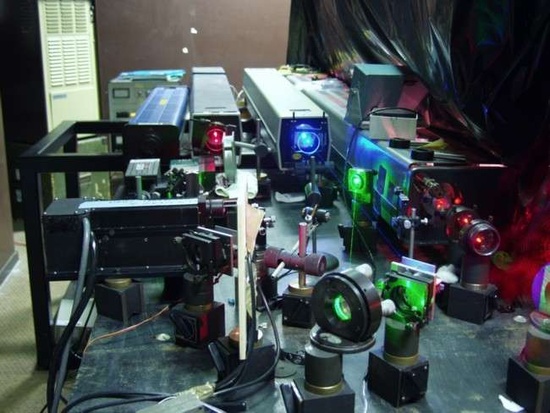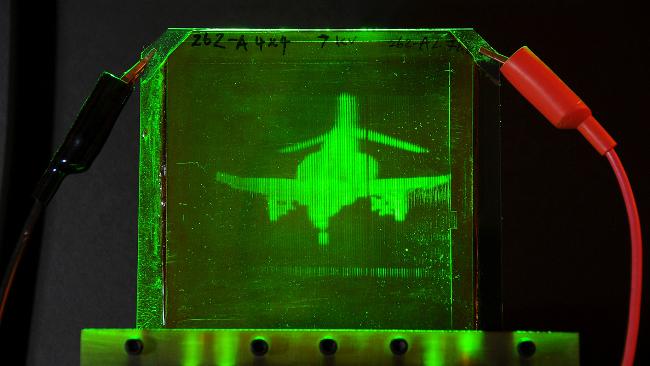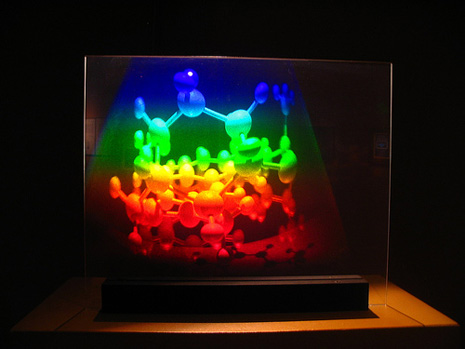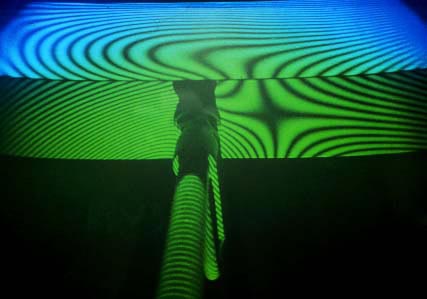Sunday, 28.Apr.2024, 3:55:38
Dr.(Phys.)Dipl.-Ing.Ralf-Udo Hartmann
Holography
The technique of holography can also be used to optically store, retrieve, and process information. While holography is commonly used to display static 3-D pictures, now it is possible to generate arbitrary scenes by a holographic volumetric display call '3D telepresence' see below!
 Though holography is often referred to as 3D photography, this is a misconception. A better analogy is sound recording where the sound field is encoded in such a way that it can later be reproduced. In holography, some of the light scattered from an object or a set of objects falls on the recording medium. A second light beam, known as the reference beam, also illuminates the recording medium, so that interference occurs between the two beams. The resulting light field is a seemingly random pattern of varying intensity which is the hologram. It can be shown that if the hologram is illuminated by the original reference beam, a light field is diffracted by the reference beam which is identical to the light field which was scattered by the object or objects. Thus, someone looking into the hologram "sees" the objects even though they are no longer present. There are a variety of recording materials which can be used, including photographic film.

 Latest Development in hologram 3D holographic volumetric display call '3D telepresence'
-Holograms used to by static -Now updated in real time -No special glasses needed  OPTICAL scientists say they have taken an important step towards producing 3D holographic video.
Holographic images that 30 years ago were static can now be updated in "quasi real time", according to the research carried out at the University of Arizona in Tucson.
Holograms are created by shining a laser on an object, causing the image to fall onto a photosensitive screen.
Bathed in a red or green laser light, the image has a "parallax", or a 3D effect, that is deep, up-and-down and side-to-side. In that regard, a hologram far outperforms stereoscopic pictures which have to be viewed with special glasses.
Two years ago, the Tucson team scaled up holography from static to mobile with technology which enabled the image to be updated on a small screen every three to four minutes.
Refinements have now enabled a screen refresh that is nearly 100 times faster, with an update every two seconds. In addition, images can be recorded and transmitted.
"We can record a three-dimensional image in one location and show it in another location, in real time, anywhere in the world," lead researcher Nasser Peyghambarian said. The image is recorded using an array of ordinary cameras, which are positioned to view the object from different perspectives - the more cameras that are used, the more complete the final holographic presentation.
The data is then encoded onto a fast-pulsing laser beam which crosses with another beam to create a so-called interference pattern, or a compression of the image in 3D form. The pattern falls upon a special film called a photorefractive polymer, which contains molecules of dye that respond to light and rotate and line up in response to an applied electrical field. The hologram that results fades away within a few minutes or alternatively can be erased and overwritten by a new image. "Let's say I want to give a presentation in New York," Mr Peyghambarian explained. "All I need is an array of cameras in my Tucson office and a fast internet connection. "At the other end, in New York, there would be the 3D display using our laser system. "Everything is fully automated and controlled by computer. "As the image signals are transmitted, the lasers inscribe them into the screen and render them into a three-dimensional projection of me speaking." In its prototype form, the device uses a 25cm screen, but a larger, 42.5cm version is in the works.
Right now, the system can only transmit images in green, but the team have already demonstrated multi-colour 3D displays and are confident it can be incorporated in the set-up in the near future. |
Menue
Search
Entries archive
Calendar
Search
|
|||||||||||||||||||||||||||||||||||||||||||||||||||||

